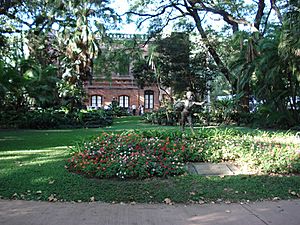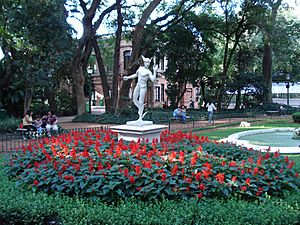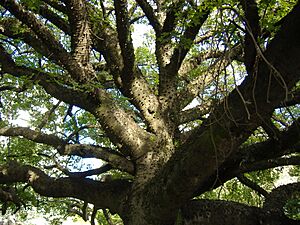Buenos Aires Botanical Garden facts for kids
Quick facts for kids Buenos Aires Botanical Garden |
|
|---|---|
| Jardín Botánico de Buenos Aires | |

Entrance to the gardens
|
|
| Location | Buenos Aires, Argentina |
| Area | 6.9772 ha (0.026939 sq mi; 17.241 acres) |
The Buenos Aires Botanical Garden is a very special place in Buenos Aires, Argentina. Its official name in Spanish is Jardín Botánico Carlos Thays de la Ciudad Autónoma de Buenos Aires. It's like a big outdoor museum for plants! You can find it in the Palermo neighborhood.
The garden has a unique triangular shape. It is bordered by Santa Fe Avenue, Las Heras Avenue, and República Árabe Siria Street.
This amazing garden was made a national monument in 1996. It covers about 7 hectares (that's like 17 acres!). Inside, you'll find around 5,500 different kinds of plants, trees, and shrubs. There are also many beautiful sculptures, monuments, and five greenhouses.
Contents
How the Garden Started
The garden was designed by a talented French architect and landscape artist named Carlos Thays. It first opened its doors on September 7, 1898.
Carlos Thays and his family actually lived in a mansion inside the gardens. They stayed there from 1892 to 1898. During this time, he was in charge of all the parks and walks in the city. The mansion was built in 1881 and is now the main building of the garden complex.
Different Plant Collections
The garden is laid out in three main styles. These are the symmetric, the mixed, and the picturesque. You can see these styles in the Roman, French, and Oriental gardens.
Roman Garden
This part of the garden has trees that the ancient Roman botanist Pliny the Younger had at his home. These include cypresses, poplars, and laurels.
French Garden
The French garden looks like the fancy gardens from France in the 17th and 18th centuries. It has a very neat and symmetric design.
Oriental Garden
In other areas, plants are grouped by where they come from. From Asia, you can see Ginkgo biloba trees. From Oceania, there are Acacias, Eucalyptus, and Casuarinas. European plants include oaks and hazelnut trees. And from Africa, you'll find brackens and palms.
Plants from Argentina and the Americas
The garden has a large collection of plants from Argentina and the Southern Cone region. You can see trees like Araucaria and Blue Patagonian Spruce. There are also many evergreen trees.
Other sections of the garden arrange plants by their scientific groups, called taxonomy. You can also find plants from other parts of the Americas. For example, there are sequoias from the United States. You can also see "Palo Borracho" (Chorisia speciosa), also known as the Floss silk tree, which comes from Brazil and Northern Argentina.
Cool Things to See
Inside the garden, there's a school called the Municipal Gardening School Cristóbal María Hicken. It works with the Faculty of Agronomy at the University of Buenos Aires.
The garden also has 33 pieces of art! These include sculptures, busts, and monuments. Some famous ones are Los primeros Fríos by Blay y Fábregas, Sagunto by Querol y Subirats, Figura de mujer by Lola Mora, and Saturnalia made of bronze by Ernesto Biondi.
Another cool feature is the five winter-houses, which are like giant greenhouses. The biggest one is built in the Art Nouveau style. It won an award at the Paris Universal Exhibition in 1889. This greenhouse is 35 meters (about 115 feet) long and 8 meters (about 26 feet) wide. It holds 2,500 tropical plants! It's thought to be the only winter-house of its style still existing in the world.
You can also see a monument called Indicador Meteorológico (Weather Indicator). It was designed by José Markovich. The Austro-Hungarian Empire community gave it to the garden for the Exposición Internacional del Centenario (1910) in 1910.
The Botanic Library has 1,000 books and 10,000 publications from all over the world. Visitors can use them for free. There's also a Botanical Museum in the park.
The Garden's Cat Friends
The Botanical Garden is also home to many friendly cats. These cats are cared for by dedicated volunteers from animal protection groups. These volunteers make sure the cats are healthy and happy.
Gallery
See also
 In Spanish: Jardín botánico de Buenos Aires para niños
In Spanish: Jardín botánico de Buenos Aires para niños








